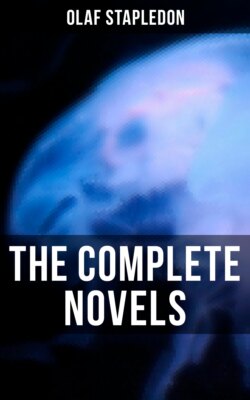Читать книгу The Complete Novels - Olaf Stapledon - Страница 76
На сайте Литреса книга снята с продажи.
1. SENTENCE OF DEATH
ОглавлениеTable of Contents
Ours has been essentially a philosophical age, in fact the supreme age of philosophy. But a great practical problem has also concerned us. We have had to prepare for the task of preserving humanity during a most difficult period which was calculated to begin about one hundred million years hence, but might, in certain circumstances, be sprung upon us at very short notice. Long ago the human inhabitants of Venus believed that already in their day the sun was about to enter the ‘white dwarf’ phase, and that the time would therefore soon come when their world would be frost-bound. This calculation was unduly pessimistic; but we know now that, even allowing for the slight delay caused by the great collision, the solar collapse must begin at some date astronomically not very distant. We had planned that during the comparatively brief period of the actual shrinkage, we would move our planet steadily nearer to the sun, until finally it should settle in the narrowest possible orbit.
Man would then be comfortably placed for a very long period. But in the fullness of time there would come a far more serious crisis. The sun would continue to cool, and at last man would no longer be able to live by means of solar radiation. It would become necessary to annihilate matter to supply the deficiency. The other planets might be used for this purpose, and possibly the sun itself. Or, given the sustenance for so long a voyage, man might boldly project his planet into the neighbourhood of some younger star. Thenceforth, perhaps, he might operate upon a far grander scale. He might explore and colonize all suitable worlds in every corner of the galaxy, and organize himself as a vast community of minded worlds. Even (so we dreamed) he might achieve intercourse with other galaxies. It did not seem impossible that man himself was the germ of the world-soul, which, we still hope, is destined to awake for a while before the universal decline, and to crown the eternal cosmos with its due of knowledge and admiration, fleeting yet eternal. We dared to think that in some far distant epoch the human spirit, clad in all wisdom, power, and delight, might look back upon our primitive age with a certain respect; no doubt with pity also and amusement, but none the less with admiration for the spirit in us, still only half awake, and struggling against great disabilities. In such a mood, half pity, half admiration, we ourselves look back upon the primitive mankinds.
Our prospect has now suddenly and completely changed, for astronomers have made a startling discovery, which assigns to man a speedy end. His existence has ever been precarious. At any stage of his career he might easily have been exterminated by some slight alteration of his chemical environment, by a more than usually malignant microbe, by a radical change of climate, or by the manifold effects of his own folly. Twice already he has been almost destroyed by astronomical events. How easily might it happen that the solar system, now rushing through a somewhat more crowded region of the galaxy, should become entangled with, or actually strike, a major astronomical body, and be destroyed. But fate, as it turns out, has a more surprising end in store for man.
Not long ago an unexpected alteration was observed to be taking place in a near star. Through no discoverable cause, it began to change from white to violet, and increase in brightness. Already it has attained such extravagant brilliance that, though its actual disc remains a mere point in our sky, its dazzling purple radiance illuminates our nocturnal landscapes with hideous beauty. Our astronomers have ascertained that this is no ordinary ‘nova’, that it is not one of those stars addicted to paroxysms of brilliance. It is something unprecedented, a normal star suffering from a unique disease, a fantastic acceleration of its vital process, a riotous squandering of the energy which should have remained locked within its substance for aeons. At the present rate it will be reduced either to an inert cinder or to actual annihilation in a few thousand years. This extraordinary event may possibly have been produced by unwise tamperings on the part of intelligent beings in the star’s neighbourhood. But, indeed, since all matter at very high temperature is in a state of unstable equilibrium, the cause may have been merely some conjunction of natural circumstances.
The event was first regarded simply as an intriguing spectacle. But further study roused a more serious interest. Our own planet, and therefore the sun also, was suffering a continuous and increasing bombardment of ethereal vibrations, most of which were of incredibly high frequency, and of unknown potentiality. What would be their effect upon the sun? After some centuries, certain astronomical bodies in the neighbourhood of the deranged star were seen to be infected with its disorder. Their fever increased the splendour of our night sky, but it also confirmed our fears. We still hoped that the sun might prove too distant to be seriously influenced, but careful analysis now showed that this hope must be abandoned. The sun’s remoteness might cause a delay of some thousands of years before the cumulative effects of the bombardment could start the disintegration; but sooner or later the sun itself must be infected. Probably within thirty thousand years life will be impossible anywhere within a vast radius of the sun, so vast a radius that it is quite impossible to propel our planet away fast enough to escape before the storm can catch us.
